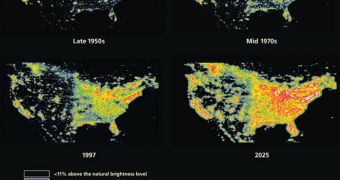Throughout the highly-urbanized world, one of the most severe problems today is the lack of starlight, and even stars for that matter, from the night sky. Light pollution is preventing this light from making its way to us, and experts now want people's help to create a global map of light pollution.
The world was never faced with this problem before the advent of electricity, and before the population soared to nearly 7 billion people. The development of metropolises has brought with it a unique phenomenon, that is always rendering the night sky too bright.
This can be observed in cities around the world, experts say. Even in the early hours of the morning, the light entering the windows is white, as it's reflected from cloud covers above. Experts say that this needs to stop, and are therefore taking efforts to ensure that this will happen.
As part of the investigation, called Globe at Night, a special website will be available between March 22 and April 6 to collect readings made by average citizens all around the world. This is the sixth time the event takes place over just as many years,
During this time, people who want to participate have to compare the way certain constellations are visible from their locations with the way these cosmic structures should look like normally. Each participant will have a standard magnitude chart at their disposal for comparison.
Last year, more than 17,800 people took part in Globe at Night, and organizers hope that a lot more will join in on the effort in 2011. Light pollution has many dangerous aspects, which need to be studied.
“With half of the world’s population now living in cities, many urban dwellers have never experienced the wonderment of pristinely dark skies and maybe never will,” the Globe at Night initiative says.
“This loss, caused by light pollution, is a concern on many fronts: safety, energy conservation, cost, health and effects on wildlife, as well as our ability to view the stars,” organizers add, quoted by Wired.
One of the main causes for this type of pollution is stray light from a variety of sources, such as billboards, public lighting, spotlights, neon signs and so on. This artificial light is poorly aimed at its targets, and therefore scatters into the atmosphere.
Once in the air, it goes on to produce a dull glow that obscures anything beyond it. The night sky, with all its stars, becomes something that is only accessible to residents in major urban areas through photos.
This pollution also harms public health, by destroying chemicals that fight against smog. These substances are mostly produced at night, and their concentrations are diminished by 7 percent, on average, at heavily polluted sites.

 14 DAY TRIAL //
14 DAY TRIAL //